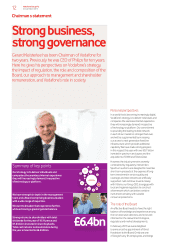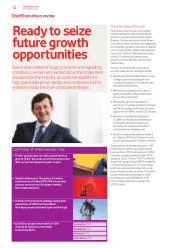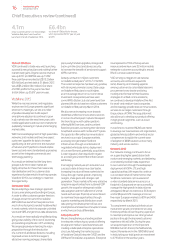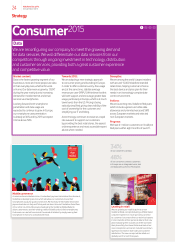Vodafone 2013 Annual Report Download - page 23
Download and view the complete annual report
Please find page 23 of the 2013 Vodafone annual report below. You can navigate through the pages in the report by either clicking on the pages listed below, or by using the keyword search tool below to find specific information within the annual report.
According to industry analysts, data is expected
to continue to be the fastest growing segment
of the mobile industry. It is estimated that
between 2012 and 20151 worldwide mobile
data revenue is set to grow by US$104 billion,
compared to a US$20 billion decline in voice
revenue over the same period. The demand
for data is being driven by a widening range
of powerful and attractive smartphones and
tablets, signicant improvements in mobile
network capability, and an increased choice
of content and applications (‘apps’).
Most of the new demand for
mobile services will be from
emerging markets
Emerging markets, such as China, India and
Africa, have the most potential for future
revenue growth driven by rising populations,
strong economic growth, lower mobile
penetration and a lack of alternative xed line
infrastructure. According to industry analysts,
by 20151 there will be 1.5 billion new mobile
users across the globe, of which over 90%
will be from emerging markets. In contrast
the more mature markets in Europe are likely
to exhibit modest growth, due to weaker GDP
growth prospects, high mobile penetration
and intense regulatory pressures.
Convergence of xed and mobile
into unied communication services
Converged xed and mobile solutions (such
as combined mobile, xed line, xed broadband
and TV) provide a range of benets for the user,
including simplicity, exibility and cost savings.
The demand for these services is already
established among enterprise customers
and it is now becoming more visible in the
consumer market, in part due to consumers’
needs to save money in a recessionary
European environment. We believe that
this demand, combined with technological
advances delivering easier connection
of multiple data devices, will support strong
growth in data-intensive applications over the
next three to ve years, and that this will need
to be managed by access to next generation
networks to support increased speed and
capacity demands.
Faster mobile networks
Today’s mobile networks are typically
a combination of 2G networks for traditional
voice, text and basic data services, and 3G
networks for fast mobile internet access
and application downloads. The latest stage
of mobile network development is superfast
4G which is already in place in some countries
– providing maximum theoretical user
speeds of up to 150 Mbps today (with typical
user speeds up to 12 Mbps, compared with
up to 6 Mbps on 3G).
Technological innovation
Alternative communication technologies, such
as instant messaging services, are increasingly
used by mobile consumers, particularly
in mature markets, such as Europe. These
services use data, rather than traditional
voice and text. This trend will continue and
in response operators, such as Vodafone, have
begun to replace per unit charges for voice
and text services with unlimited bundles and
combine this with a xed fee for data usage.
New applications for mobile services are being
developed by the industry to extend the use
of mobile beyond everyday communication,
such as mobile payments via a handset
or M2M services, including the location
monitoring of vehicles, through a SIM card
embedded in the vehicle.
Where the industry
isheading
The pace of change in the mobile industry over the
last few years has been signicant and is expected to
continue. We anticipate growing sources of revenue
from data services such as mobile internet usage; higher
penetration of smartphones and tablets; new users from
emerging markets; and major advancements in mobile
network technology to deliver faster and better customer
services. The demand for seamless converged xed and
mobile solutions using high speed networks is expected
to accelerate.
Mobile service revenue by type
Mobile phone users by market
Maximum mobile data Mbps
downlink speeds
2007 92%
75%
67%
8%
25%
33%
2012
2015
Data Voice, SMS and other
2007 40%
27%
24%
60%
73%
76%
2012
2015
Emerging markets Mature markets
2007
150
300
7.2
43.2
86.4
2012
2015
3G 4G
Regulatory pressures
The industry is expecting to see continued
downward revenue pressure from regulated
cuts to termination rates, and voice and data
roaming prices. European regulators are also
seeking to encourage investment in high
speed data services. However, the policies
to achieve this have not been conrmed
by either European or national regulators and
therefore the impact on the mobile sector
is difcult to judge.
Note:
1 Refers to calendar year.
21 Vodafone Group Plc
Annual Report 2013
Overview Business
review Performance Governance Financials Additional
information
























